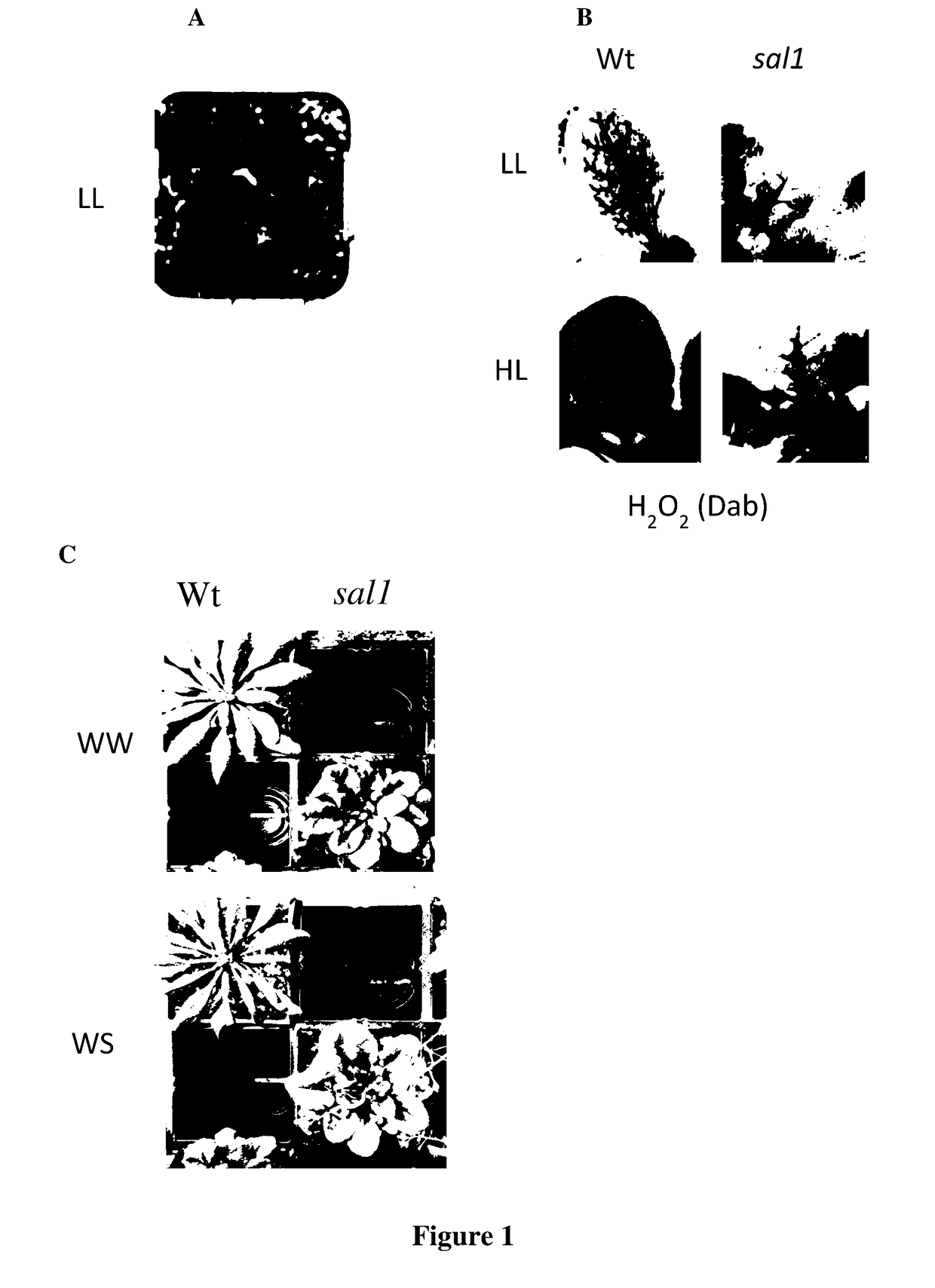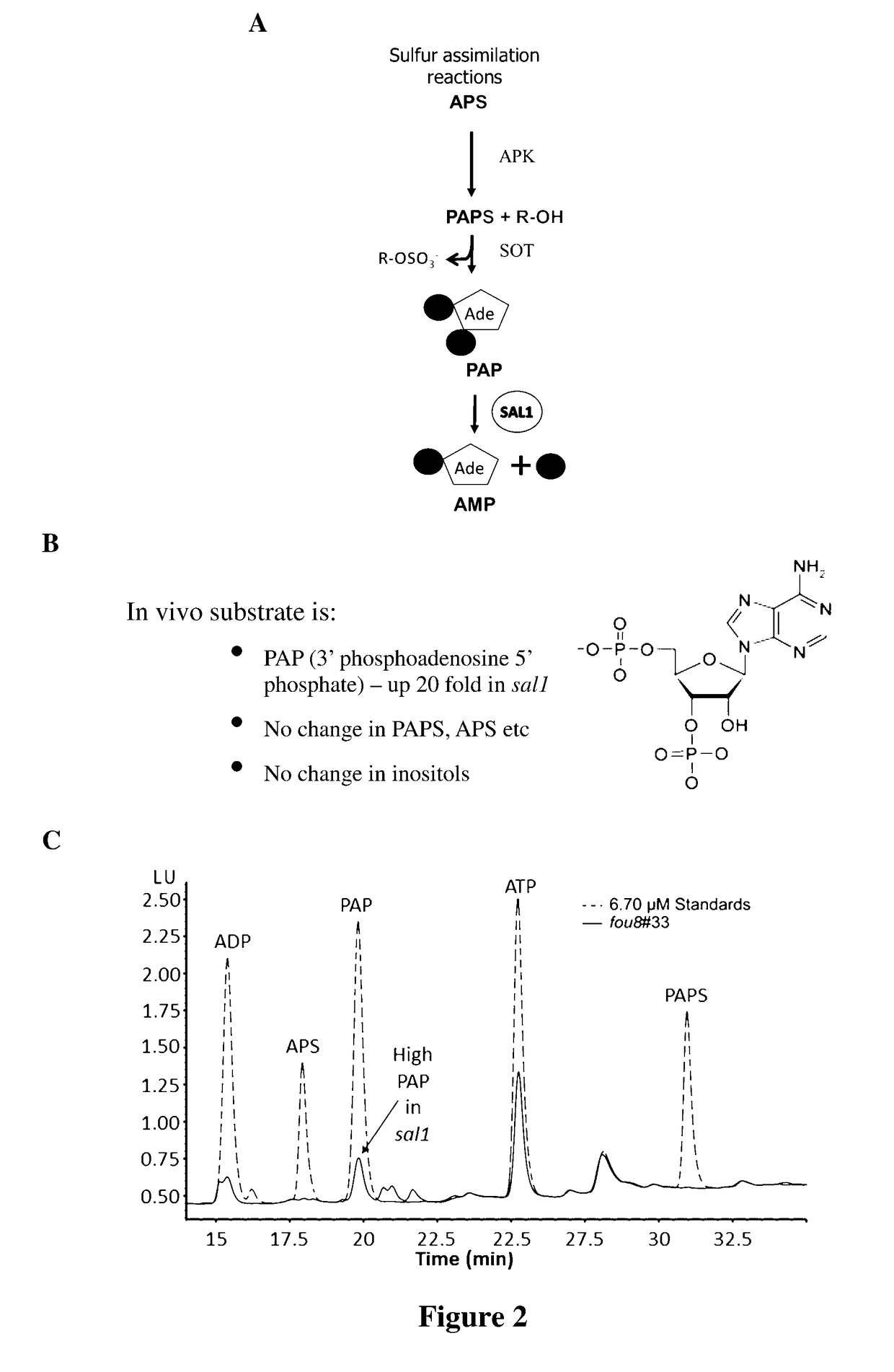Method for Increasing Plant Stress Tolerance and Seed Dormancy
a technology of stress tolerance and plant stress, applied in the field of increasing plant stress tolerance and seed dormancy, can solve the problems of heat stress and the limitations of existing methods for improving plant stress resistance, and achieve the effect of reducing sal1 and reducing the root mean square fluctuation (rmsf)
- Summary
- Abstract
- Description
- Claims
- Application Information
AI Technical Summary
Benefits of technology
Problems solved by technology
Method used
Image
Examples
example 1
and Methods
Plant Materials, Growth and Stress Conditions
[0160]Seeds were germinated in soil and kept at 4° C. for 3 days to synchronize germination. Seedlings were grown at 100-150 μmol photons m−2 s−1, 12 h photoperiod, 21-23° C. and 50-55% humidity, unless otherwise stated.
[0161]In some experiments, the alx8 mutant (Col-0 background) was crossed with abi1-1, ost1-2 in the Ler background in order to generate double mutants. Homozygous F2 plants were screened using derived cleavable amplified polymorphic sequence (dCAPS) markers to confirm the presence of individual mutations and sequenced.
[0162]The Col-0 Ler F1 hybrid was generated as a control and in most experiments wild type refers to the F1 hybrid; otherwise both parental genotypes were used.
[0163]The ost1-2 snrk2.2 snrk2.3 triple mutant was obtained from Prof. Sean Cutler (University of California, Riverside) and crossed to the SAL1 null allele fry1-6 to generate the quadruple mutant.
[0164]Drought stress treatment was performe...
example 2
Studies
[0198]As previously reported (International patent publication no. WO 2008 / 154695; Rossel J. B. et al (2007), Plant Cell 19(12):4091-4110 and in Wilson P. B. et al (2009), Plant Journal 58(2): 299-317), an Arabidopsis thaliana mutant, alx8 comprised a mutation in the gene encoding SAL1, that reduced expression of this protein. This plant, as well as other Arabidopsis thaliana plants comprising a mutation in this gene and deficient in SAL1 expression, were found to grow substantially normally under well-watered (WW), and normal to low light (LL) conditions (FIGS. 1A, 1C). However, under high light (HL) stress and water-stressed (WS) conditions, the sal1 mutants were found to accumulate less reactive oxidation species (ROS) (FIG. 1B) and to tolerate water-stressed conditions better (FIG. 1C) than wild-type plants.
[0199]Previous studies (Estavillo G. M. et al (2011), Plant Cell 23(11): 3992-4012) also showed that PAP is the substrate for SAL1, rather than PAPS or IPS as previous...
example 3
AP Accumulate During Drought Stress and Regulate Stomatal Closure
[0204]Our studies reveal that the two metabolites, ABA and PAP, accumulate concurrently under drought conditions (FIG. 5A). Exogenous ABA stimulates PAP accumulation by four fold, reaching levels similar to those observed in 6 days water stressed wild type leaves. This ABA-mediated PAP accumulation was not due to a change in SAL1 activity, but may have proceeded via stimulation of PAP synthesis.
[0205]We hypothesized that the SAL1-PAP retrograde pathway may be directly involved in guard cell signaling. If this is the case the pathway should be present in guard cells and manipulation of it should alter stomatal dynamics. Indeed, in addition to the vasculature SAL1 is enriched in epidermal peels and localized to chloroplasts of guard cells. Second, treatment of leaf peels with PAP elicited rapid stomatal closure similar to the ABA response (FIGS. 5C and 5D). Moreover, a stronger, cumulative response was achieved when in v...
PUM
| Property | Measurement | Unit |
|---|---|---|
| stress tolerance | aaaaa | aaaaa |
| conformational changes | aaaaa | aaaaa |
| conformational | aaaaa | aaaaa |
Abstract
Description
Claims
Application Information
 Login to View More
Login to View More - R&D
- Intellectual Property
- Life Sciences
- Materials
- Tech Scout
- Unparalleled Data Quality
- Higher Quality Content
- 60% Fewer Hallucinations
Browse by: Latest US Patents, China's latest patents, Technical Efficacy Thesaurus, Application Domain, Technology Topic, Popular Technical Reports.
© 2025 PatSnap. All rights reserved.Legal|Privacy policy|Modern Slavery Act Transparency Statement|Sitemap|About US| Contact US: help@patsnap.com



